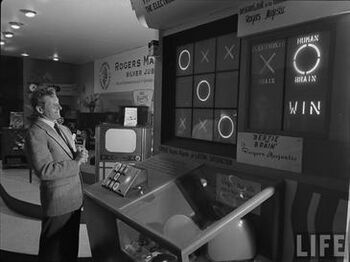Bertie the Brain facts for kids
Quick facts for kids Bertie the Brain |
|
|---|---|

Comedian Danny Kaye having just beaten the machine
|
|
| Designer(s) | Josef Kates |
| Platform(s) | Custom |
| Release date(s) | August 25, 1950 |
| Genre(s) | Tic-tac-toe |
| Mode(s) | Single-player |
Bertie the Brain was one of the very first computer games ever made. It was built in Toronto, Canada, by a smart scientist named Josef Kates. Bertie was shown at the 1950 Canadian National Exhibition, a big fair.
This giant computer was 4 meters (13 feet) tall! People at the fair could play a game of tic-tac-toe against it. Bertie used a special keypad for players to make their moves. The game then showed the moves on a grid of lights above. You could even change how hard the game was!
Bertie was created to show off a new invention by Kates called the additron tube. This was a smaller version of a vacuum tube, an important part of early computers. After two weeks, Bertie was taken apart and mostly forgotten. But it's still an important part of video game history!
What Was Bertie the Brain?
Bertie the Brain was a special computer designed to play tic-tac-toe. It was built by Josef Kates for a big event in 1950. Kates wanted to show off his new invention, the additron tube. This tube was a tiny electronic part.
Kates had worked on radar tubes during World War II. Later, he helped build one of the first computers in the world. He then invented the additron tube. His company, Rogers Majestic, wanted a way to show how amazing this new tube was. So, Kates designed Bertie the Brain!
This huge computer was installed at the Canadian National Exhibition. It was there from August 25 to September 9, 1950. Bertie was a big hit at the fair! People lined up to play against the "Electronic Wonder." Kates even adjusted the difficulty for kids and adults. A famous comedian, Danny Kaye, was even photographed beating Bertie for Life magazine!
How Did Bertie Play?
Playing Bertie the Brain was like playing a giant game of tic-tac-toe. Players chose their move by pressing one of nine lit buttons. These buttons were on a raised panel.
Once a player made a move, an X or O light would turn on. This showed the move on a big grid of squares on the machine. Then, the computer would make its move very quickly.
Signs next to the game lit up to show whose turn it was. One sign said "Electronic Brain" with an X, and the other said "Human Brain" with an O. When someone won, the word "Win" would light up. Bertie could be set to different difficulty levels. At its hardest, the computer was designed to be unbeatable!
Why Was Bertie Important?
After the fair, Bertie was taken apart. It was mostly forgotten as just a fun thing from the exhibition. Kates was busy with many other projects. He didn't have time to save it.
Bertie was one of the first computer games ever made. It even appeared in a magazine article that was never published. But many video game history books didn't mention it.
Bertie's main goal was to promote the additron tube. But this didn't happen. The additron tube was the only time this technology was fully used. It took a long time to get patents for the tubes outside Canada. By the time they did, a better invention called the transistor had come along. Transistors were much better than vacuum tubes. So, Bertie and similar machines were never made again.
Even though it used light bulbs instead of a screen, Bertie was special. It was one of the first computer games to have any kind of visual display. This makes it a candidate for being the very first video game!
Images for kids


